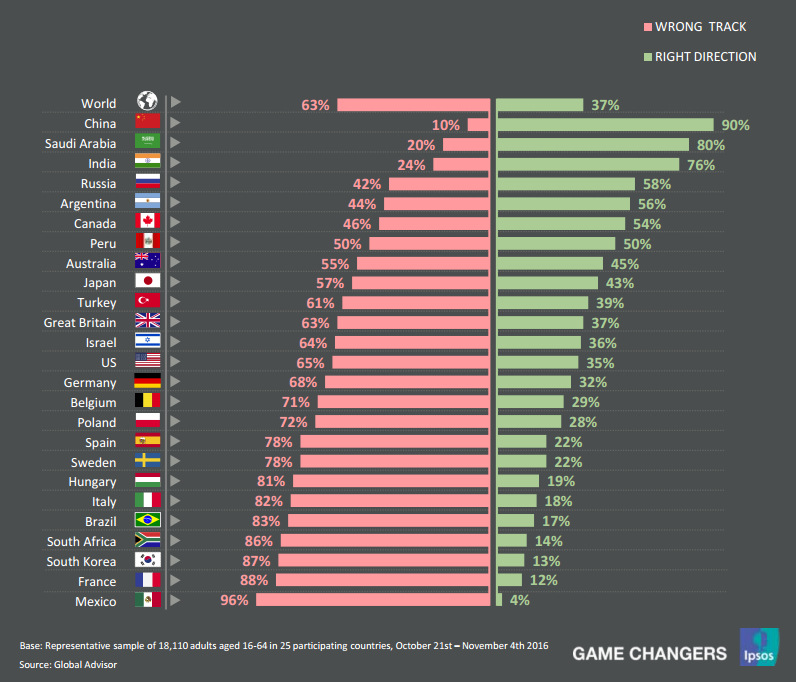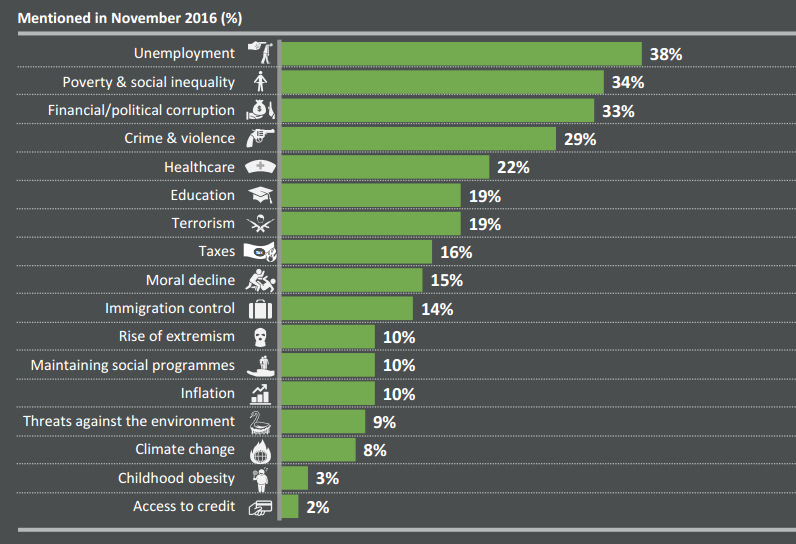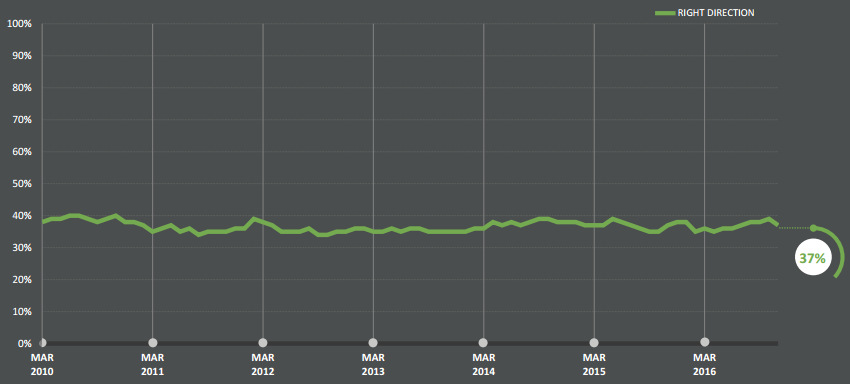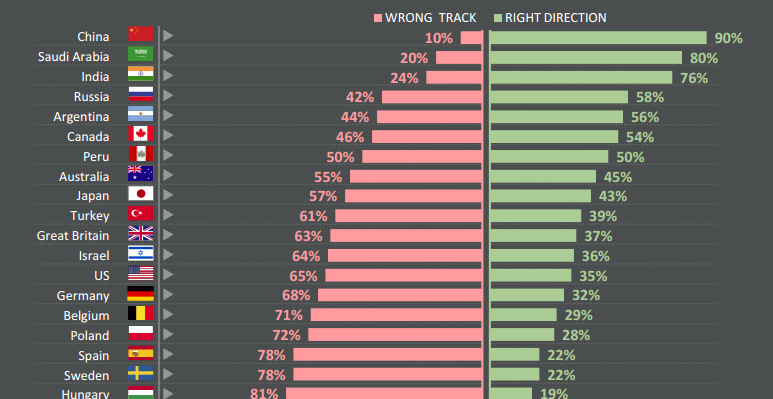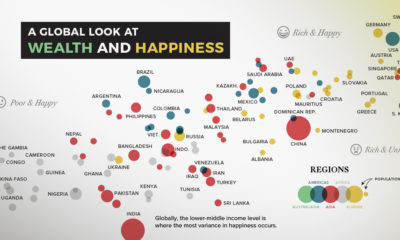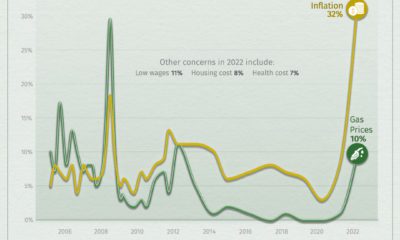But if you ditch the complexity and nuance surrounding current events, we can get a good gauge by asking a simple and direct question to people: are things going in the right direction? Today’s data comes from the What Worries the World Report by Ipsos Public Affairs. It sums up responses from 18,110 people in 25 different countries on whether things are going in the “right direction” or “wrong direction” in their particular country.
The Right or Wrong Direction?
First of all, here is the official question posed by Ipsos – and the results sorted by country: Generally speaking, would you say things in this country are heading in the right direction, or are they off on the wrong track?
On a global basis, 37% of people think their countries are heading in the “right direction”, though that varies for each individual country. Respondents from China and Saudi Arabia are the most enthusiastic, with 90% and 80% of people respectively answering that things are on the right track. That said, it would be interesting to look at Ipsos’ methodology here to see how they are ensuring valid responses from people under the rule of more autocratic regimes. The United States and Canada were in the middle of the pack. Only 35% Americans see things as being on the right track, while 54% of Canadians feel the same way. Generally speaking, Europeans, Mexicans, Brazilians, and South Koreans are the most pessimistic about future prospects.
Hot Button Issues
What issues have got people feeling this way? Respondents were asked to select their top three worries from a set of 17 options:
The two biggest global worries are both economic in nature: “Unemployment” and “Poverty & Social Inequality” were selected by 38% and 34% of people respectively. Issues such as “Terrorism”, “Rise of Extremism” or “Immigration Control” are surprisingly in the middle of the pack, though it is worth keeping in mind that the above data is at a global level. These issues would likely rank higher in Western countries than in places like China, Russia, or India.
Trending Up or Down
With only 37% of global respondents seeing their country being “on track”, does that rank higher or lower than in previous surveys?
Interestingly, it is basically par for the course. Since 2010, the results have basically trended sideways, with the percentage of people for “on track” never cracking 40% on a global level. on The good news is that the Federal Reserve, U.S. Treasury, and Federal Deposit Insurance Corporation are taking action to restore confidence and take the appropriate measures to help provide stability in the market. With this in mind, the above infographic from New York Life Investments looks at the factors that impact bonds, how different types of bonds have historically performed across market environments, and the current bond market volatility in a broader context.
Bond Market Returns
Bonds had a historic year in 2022, posting one of the worst returns ever recorded. As interest rates rose at the fastest pace in 40 years, it pushed bond prices lower due to their inverse relationship. In a rare year, bonds dropped 13%.
Source: FactSet, 01/02/2023.
Bond prices are only one part of a bond’s total return—the other looks at the income a bond provides. As interest rates have increased in the last year, it has driven higher bond yields in 2023.
Source: YCharts, 3/20/2023.
With this recent performance in mind, let’s look at some other key factors that impact the bond market.
Factors Impacting Bond Markets
Interest rates play a central role in bond market dynamics. This is because they affect a bond’s price. When rates are rising, existing bonds with lower rates are less valuable and prices decline. When rates are dropping, existing bonds with higher rates are more valuable and their prices rise. In March, the Federal Reserve raised rates 25 basis points to fall within the 4.75%-5.00% range, a level not seen since September 2007. Here are projections for where the federal funds rate is headed in 2023:
Federal Reserve Projection*: 5.1% Economist Projections**: 5.3%
*Based on median estimates in the March summary of quarterly economic projections.**Projections based on March 10-15 Bloomberg economist survey. Together, interest rates and the macroenvironment can have a positive or negative effect on bonds.
Positive
Here are three variables that may affect bond prices in a positive direction:
Lower Inflation: Reduces likelihood of interest rate hikes. Lower Interest Rates: When rates are falling, bond prices are typically higher. Recession: Can prompt a cut in interest rates, boosting bond prices.
Negative
On the other hand, here are variables that may negatively impact bond prices:
Higher Inflation: Can increase the likelihood of the Federal Reserve to raise interest rates. Rising Interest Rates: Interest rate hikes lead bond prices to fall. Weaker Fundamentals: When a bond’s credit risk gets worse, its price can drop. Credit risk indicates the chance of a default, the risk of a bond issuer not making interest payments within a given time period.
Bonds have been impacted by these negative factors since inflation started rising in March 2021.
Fixed Income Opportunities
Below, we show the types of bonds that have had the best performance during rising rates and recessions.
Source: Derek Horstmeyer, George Mason University 12/3/2022. As we can see, U.S. ultrashort bonds performed the best during rising rates. Mortgage bonds outperformed during recessions, averaging 11.4% returns, but with higher volatility. U.S. long-term bonds had 7.7% average returns, the best across all market conditions. In fact, they were also a close second during recessions. When rates are rising, ultrashort bonds allow investors to capture higher rates when they mature, often with lower historical volatility.
A Closer Look at Bond Market Volatility
While bond market volatility has jumped this year, current dislocations may provide investment opportunities. Bond dislocations allow investors to buy at lower prices, factoring in that the fundamental quality of the bond remains strong. With this in mind, here are two areas of the bond market that may provide opportunities for investors:
Investment-Grade Corporate Bonds: Higher credit quality makes them potentially less vulnerable to increasing interest rates. Intermediate Bonds (2-10 Years): Allow investors to lock in higher rates.
Both types of bonds focus on quality and capturing higher yields when faced with challenging market conditions.
Finding the Upside
Much of the volatility seen in the banking sector was due to banks buying bonds during the pandemic—or even earlier—at a time when interest rates were historically low. Since then, rates have climbed considerably. Should rates moderate or stop increasing, this may present better market conditions for bonds. In this way, today’s steep discount in bond markets may present an attractive opportunity for price appreciation. At the same time, investors can potentially lock in strong yields as inflation may subside in the coming years ahead. Learn more about bond investing strategies with New York Life Investments.
